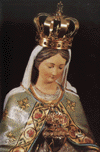Our Lady of the Cape
Our Lady of the Cape
Q: Describe the origins of Mary's title: Our Lady of the Cape. Are there images associated with it?
A: The shrine of Our Lady of the Cape or Notre-Dame-du-Cap is located on the St. Lawrence River in the town of Cap-de-la-Madeleine (Quebec).
The statue of Our Lady of the Cape has been venerated since 1854 when it was donated to the sanctuary (which has been in existence since 1694) by Zepherin Dorval, who was about to take part in the Klondyke gold rush. It is one of eleven identical statues made in Canada by an unknown Italian sculptor. The statue portrays Our Lady as she appeared to Catherine Laboure in 1830. This event is known as the Miraculous Medal apparition. It shows Mary without the child Jesus, her arms outstretched toward the people, standing on a half-globe, her foot/heal crushing the head of the snake. The Miraculous Medal representations bears the well-known inscription: "O Mary, conceived without sin, pray for us." The reverse of the medal shows the capital letter M surrounded by twelve stars. There exists in the Miraculous Medal a double allusion to the beginning (snake) and the end of Scripture (the lady surrounded by stars).

Our Lady of the Cape statue is essentially a representation of the Immaculate Conception (cf Gen 3:15), inviting her prayer of intercession. The reference to Revelations 12 is not evident (in the statue) but may be assumed. However, there are other motifs which go beyond the iconography of the Miraculous Medal. First, there is the burning heart on the upper part of her body. This symbol is part of the original statue donated in 1854, and suggests a different iconographical tradition which goes back to the fourteenth century, and which achieved considerable popularity in the eighteenth century (i.e. Mary pictured with a heart in her hand or on her chest).
The meaning of the heart of Mary is one of burning love beating in union with the heart of her son, and partaking in his suffering. The other characteristic element of the statue of Our Lady of the Cape is her crown. It was added in 1904 (on October 12) to commemorate the fiftieth anniversary of the definition of the Immaculate Conception. The coronation honors and highlights, in particular, the miraculous character of the statue. In fact, since the so-called "ice bridge" miracle of 1878 [when a ribbon of solid ice formed across the St. Lawrence River and thus made possible the transportation of 175 loads of supplies for the construction of the new sanctuary] attributed to Our Lady, her image has been considered miraculous.
The image has still another meaning. The original dedication of the sanctuary was to Our Lady of the Rosary, patroness of a rosary confraternity which is the true origin of this pilgrimage -- today considered the third largest in Canada. Thus the statue of 1854 [which replaced an older one which vanished without a trace and is mentioned in parish records as "The Golden Virgin"] automatically became Our Lady of the Rosary. On occasion (e.g. procession, etc.) the shrine statue holds a golden rosary in her hands.
All About Mary includes a variety of content, much of which reflects the expertise, interpretations and opinions of the individual authors and not necessarily of the Marian Library or the University of Dayton. Please share feedback or suggestions with marianlibrary@udayton.edu.
